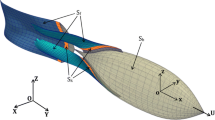Abstract
The study of fish-like bodies moving in liquid is an interesting and challenging research subject in the fields of biolocomotion and biomimetics. Typically the effect of tail oscillation on fluid flow around such a body is highly unsteady, generating vortices and requiring detailed analysis of fluid-structure interactions. An understanding of the complexities of such flows is of interest not only to biologists but also to engineers interested in developing vehicles capable of emulating the high performance of fish propulsion and manoeuvring. In the present study, a computational fluid dynamic (CFD) simulation of a three-dimensional biomimetic fish-like body has been developed to investigate the fluid flows around this body when moving in a viscous liquid. A parametric analysis of the variables that affect the flow surrounding the body is presented, along with flow visualisations, in an attempt to quantify and qualify the effect that these variables have on the performance of the body. The analysis provided by the unsteady transient simulation of a fish-like body has allowed the flow surrounding a fish-like body undergoing periodic oscillations to be studied. The simulation produces a motion of the tail in the (x, y) plane, with the tail oscillating as a rigid body in the form of a sinusoidal wave.
Similar content being viewed by others
References
Techet A H, Triantafyllou M S. Boundary layer relaminarization in swimming fish. Proceedings of the Ninth International Offshore and Polar Engineering Conference, Brest, France, 1999.
Bannasch R. Hydrodynamics of wave-like curvature on bodies of swimming animals. Proceedings of the International Symposium on Seawater Drag Reduction, Newport, Rhode Island, USA, 1998, 435–442.
Triantafyllou M S, Triantafyllou G S, Yue D K P. Hydrodynamics of fishlike swimming. Annual Review of Fluid Mechanics, 2000, 32, 33–53.
Lyttle A D, Blanksby B A, Elliot B C, Lloyd D G. Net forces during tethered simulation of underwater streamlined gliding and kicking techniques of the freestyle turn. Journal of Sports Science, 2000, 18, 801–807.
Liu H, Wassersug R J, Kawachi K. A Computational fluid dynamic study of tadpole swimming. The Journal of Experimental Biology, 1996, 199, 1245–1260.
Liu H, Wassersug R J, Kawachi K. The three-dimensional hydrodynamics of tadpole. The Journal of Experimental Biology, 1997, 200, 2807–2819.
Cheng J Y, Zhuang L X, Tong B G. Analysis of swimming three-dimensional waving plates. Journal of Fluid Mechanics, 1991, 232, 341–355.
FLUENT 6.2 Documentation. FLUENT, 2005.
Zhu Q, Wolfgang M J, Yue D K P, Triantafyllou M S. Three-dimensional flow structures and vorticity control in fish-like swimming. Journal of Fluid Mechanics, 2002, 468, 1–28.
Barrett D S, Triantafyllou M S, Yue D K P, Grosenbaugh M A, Wolfgang M. Drag reduction in fish-like locomotion. Journal of Fluid Mechanics, 1999, 392, 183–212.
Author information
Authors and Affiliations
Rights and permissions
About this article
Cite this article
Adkins, D., Yan, Y.Y. CFD simulation of fish-like body moving in viscous liquid. J Bionic Eng 3, 147–153 (2006). https://doi.org/10.1016/S1672-6529(06)60018-8
Published:
Issue Date:
DOI: https://doi.org/10.1016/S1672-6529(06)60018-8




